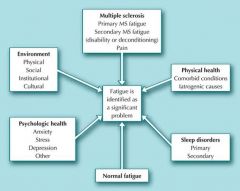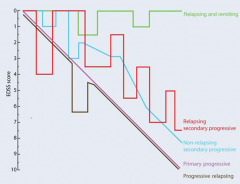![]()
![]()
![]()
Use LEFT and RIGHT arrow keys to navigate between flashcards;
Use UP and DOWN arrow keys to flip the card;
H to show hint;
A reads text to speech;
18 Cards in this Set
- Front
- Back
|
MS is a disease affecting the _______
|
-CNS
|
|
|
MS is more common in men or women?
|
-WOMEN
^^ sucks to be them |
|
|
T or F:
incidence of MS is correlated to location and latitude? |
TRUE
Incidence of MS and geographic latitude strongly correlated; the farther one travels from the earth's equator, the more cases of MS per capita. Great Britain, Scandinavia and Canada have 3 of the highest rates of MS in the world. |
|
|
The two ways to clinically diagnosis MS are dissemination in _______ and dissemination in ________.
|
-TIME: occurrence of two or more distinct attacks.
-Space: Objective clinical evidence of two or more lesions in separate locations within the myelinated regions of the CNS |
|
|
How is optic neuritis described?
|

"cellophane in eye"
-Optic Neuritis is one of the most common initial symptoms of MS and presents unilaterally in 70% of cases. |
|
|
Describe Uhthoffs phenomenon?
|
increase or presence in neurological symptoms in response to a heating condition. Change in body temp that elicits signs ranges from .18ºF- 4.14ºF).
|
|
|
T or F:
A majority of MS patients have heat intolerance? |
TRUE:
-80% of MS patients are sensitive to changes in core body temperature, from both external (environment) and internal (vigorous exercise) sources. |
|
|
What is described as their worst, or one of their worst symptoms?
|
-FATIGUE
|
|
|
LOOK AT PIC
|

pic
|
|
|
What type of MS do most patients start with?
|
RRMS
-Relapsing-Remitting MS (RRMS) 80% of individuals with MS start as RRMS; women three times more likely to be diagnosed than men |
|
|
Describe RRMS briefly in general terms:
|
Temporary symptom flare-ups or “exacerbations” (a.k.a. relapses, attacks, or bouts) typically last 1-3 months, followed by remissions (complete or partial recovery).
|
|
|
Untreated RRMS may become ________?
|
If untreated, >90% of individuals with RRMS may enter a second phase, called secondary progressive MS (SPMS) within 6-10 years. Characterized by progressive worsening of symptoms, with or without relapses.
|
|
|
PICTURE FOR TYPES OF MS
|

pic
|
|
|
What are some symptoms that give a worse prognosis with MS?
|
-Progressive (chronic) MS
-Onset after 40, especially males -Significant pyramidal and cerebellar signs with involvement at multiple sites at 5 years after diagnosis. -African American |
|
|
How are exacerbation of MS treated?
|
Exacerbations treated with a high-dose, short-term course of corticosteroids (IV methylprednisolone, then oral prednisone).
|
|
|
T or F:
High level evidence that exercise is effective in improving strength and endurance, self-efficacy, and quality of life in patients with MS |
TRUE
|
|
|
___________ like symptoms are common with MS medication
|
-Flu like
|
|
|
Look over these for the Kurtzke Expanded Disability Status Scale
|
-0.0: Normal Neurological Exam
-1.0: No disability, minimal signs on 1 FS -1.5: No disability, minimal signs on 2 of 7 FS -2.0: Minimal disability in 1 of 7 FS -2.5: Minimal disability in 2 FS -3.0: Moderate disability in 1 FS; or mild disability in 3 - 4 FS, though fully ambulatory -3.5: Fully ambulatory but with moderate disability in 1 FS and mild disability in 1 or 2 FS; or moderate disability in 2 FS; or mild disability in 5 FS -4.0: Fully ambulatory without aid, up and about 12hrs a day despite relatively severe disability. Able to walk without aid 500 meters -4.5: Fully ambulatory without aid, up and about much of day, able to work a full day, may otherwise have some limitations of full activity or require minimal assistance. Relatively severe disability. Able to walk without aid 300 meters -5.0: Ambulatory without aid for about 200 meters. Disability impairs full daily activities -5.5: Ambulatory for 100 meters, disability precludes full daily activities -6.0: Intermittent or unilateral constant assistance (cane, crutch or brace) required to walk 100 meters with or without resting -6.5: Constant bilateral support (cane, crutch or braces) required to walk 20 meters without resting -7.0: Unable to walk beyond 5 meters even with aid, essentially restricted to wheelchair, wheels self, transfers alone; active in wheelchair about 12 hours a -day -7.5: Unable to take more than a few steps, restricted to wheelchair, may need aid to transfer; wheels self, but may require motorized chair for full day's activities -8.0: Essentially restricted to bed, chair, or wheelchair, but may be out of bed much of day; retains self care functions, generally effective use of arms -8.5: Essentially restricted to bed much of day, some effective use of arms, retains some self care functions -9.0: Helpless bed patient, can communicate and eat -9.5: Unable to communicate effectively or eat/swallow -10.0: Death due to MS |

